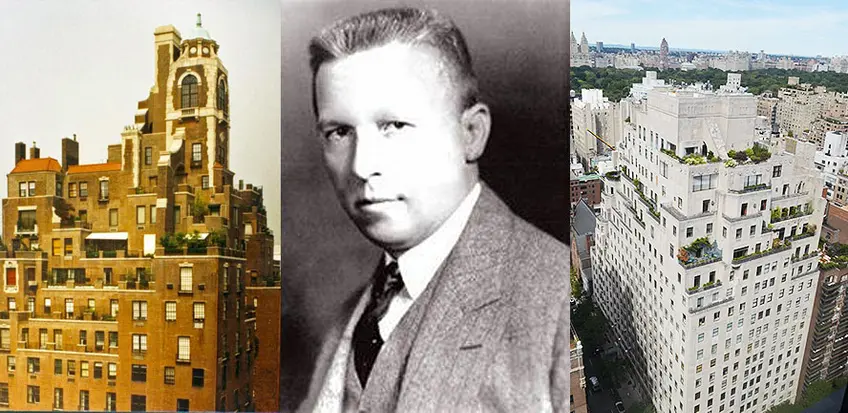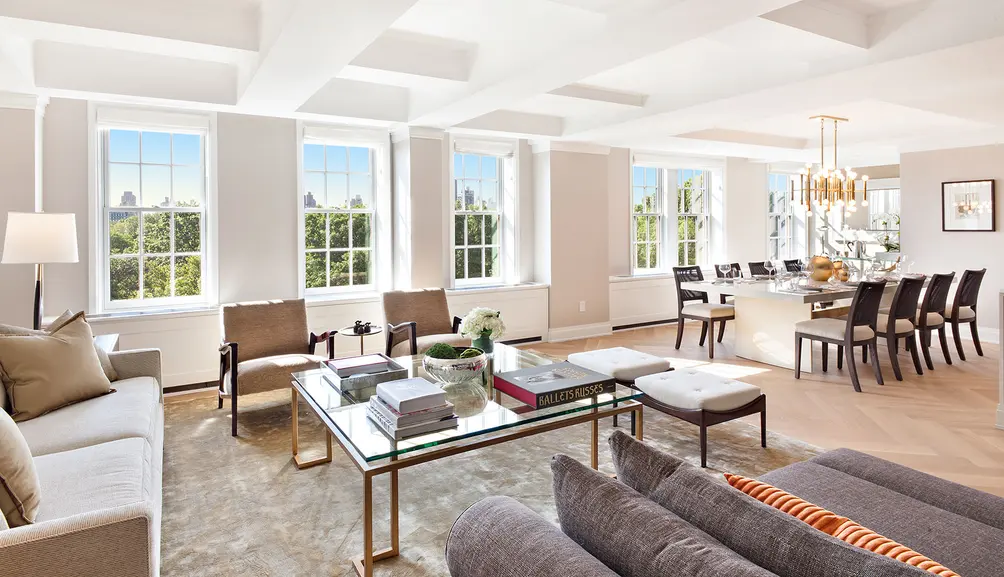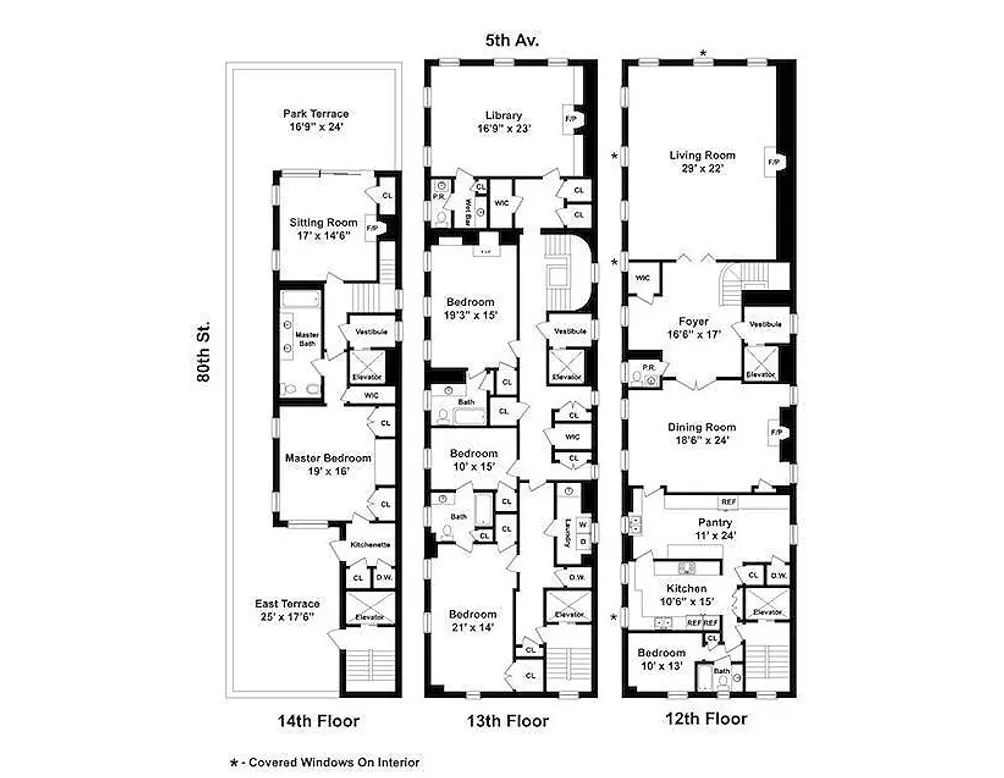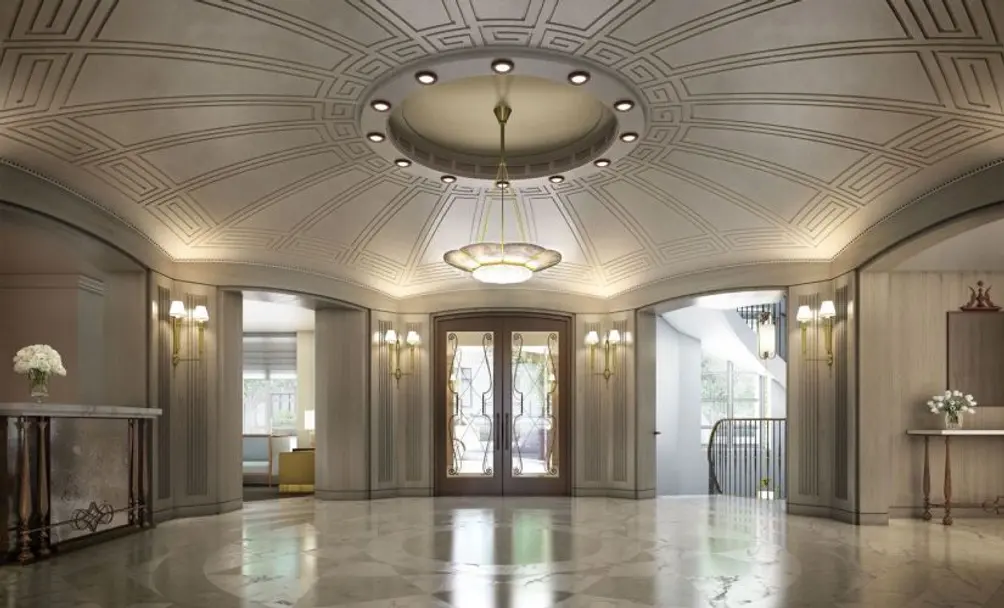
Architect Rosario Candela had a vision of the luxury apartment building that differed from the designs that existed in the early 1900s in New York City—and that vision has stood the test of time. The son of a Sicilian plasterer, Candela arrived in the city in 1909 to join his father, a plasterer. Candela studied architecture in Columbia University, began working around 1920, a made a name for himself as the designer of some of New York’s most coveted addresses including 740 Park Avenue, 834 Fifth Avenue, and 1 Sutton Place South. A Candela building is like a Louis Vuitton handbag—understated yet obvious, a status symbol that everyone lusts for but few can afford. “Rosario Candela has replaced Stanford White as the real estate brokers’ name-drop of choice,” writes columnist, Christopher Gray.
"People who want a Candela building are looking toward history and that classic feeling of moldings, beautiful wood floors, and a more intimate setting"
 Interior of a unit at 360 Central Park West
Interior of a unit at 360 Central Park West
Today, Candela buildings are once more in demand as a counterpoint to the sleek glass and steel new developments that have been altering the skyline over the past decade. “People who want a Candela building are looking toward history and that classic feeling of moldings, beautiful wood floors, and a more intimate setting,” a representative of the Candela building conversion at 360 Central Park West tells CityRealty. “People who buy in a Candela building versus a super modern building have an appreciation for old New York.”
Residential apartment buildings in the early 1900s were noisy and rough with exterior walls that were too thin and exposed wiring and pipes, says interior designer David Netto. “Candela thickened those walls to conceal the structural framing and to carry plumbing risers unseen. Instead of pairing windows as was the custom to admit more light, Candela made windows larger and spaced them in majestic single succession endowing his rooms with a feeling of greater scale and balance. These refinements, along with higher ceilings and carefully considered vistas from one room to the next, made Candela's a richer architecture than New York apartments had ever known or would see again.” Candela had a legendary attention to detail, as in seen in his building at 990 Fifth Avenue. “For the all-duplex 990 Fifth Avenue, built in 1927, Douglas Elliman & Company plotted the path of the sun for an entire year to determine the best exposures for apartments,” writes Christopher Gray in a 1988 New York Times article.
 Floor plan of a triplex in 990 Fifth Avenue previously on the market for $29M
Floor plan of a triplex in 990 Fifth Avenue previously on the market for $29M
The demand for pre-war Candela apartments is rising, but these apartments rarely become available, especially on corridors like Central Park West where most everything is a co-op. Once in a blue moon, when one of these residences goes on the market, buyers have to meet the stringent demands of the board, which may include as much as $100 million liquidity and a profusion of personal information. “There are a lot of rules and regulations that one needs to abide by in a co-op, everything from renovating your apartment, to when you can renovate it, and what you can and cannot do,” one source working closely with 360 Central Park West says. “Condos and newer inventory tend to provide buyers an easier lifestyle.”
To increase the supply and meet the demand for pre-war Candela condominiums, Argo Real Estate hired CetraRuddy Architects to convert 360 Central Park West from rentals into sophisticated residences. Originally built in 1929, thirteen apartments, renovated and updated for the 21st century, went on the market in June 2015. Typical of Candela buildings, the exterior is a conservative, refined limestone, while the residences reflect his signature style. Interiors feature coffered ceilings, five-inch solid oak herringbone floors, floor-to-ceiling cerused oak millwork-concealed appliances, custom-made Italian range copper hoods, honed Italian marble countertops, crown moldings, freestanding bathtubs, and custom cabinetry. In addition to the usual white glove amenities like an attended lobby, children’s playroom, and a fitness center, there’s even a pet grooming station. Currently, apartments are listed at $885,000 for a studio up to $6,300,000 for a three-bedroom.
Another Candela building currently being converted from rentals to condominiums, 12 East 88th Street sits across from the Guggenheim Museum. Simon Baron Development commissioned renowned designer Vincente Wolf to “reinterpret Candela” for the interiors and architect Kinlin Rutherford for the expansive floor plan designs. Residences are a mix of expansive apartments, townhouses, and penthouses with views of Central Park. This boutique condominium’s opulent finishes include mahogany-stained white oak floors, fireplaces with granite slab hearths, Calacatta marble kitchens with wine refrigerators, warming drawers, and wet bars.
There’s a shift away from the open layouts that have dominated the market to new developments that feature Candela-inspired layouts with separation between the public and private spaces
Developers have noted that there’s a shift away from the open layouts that have dominated the market to new developments that feature Candela-inspired layouts with separation between the public and private spaces.
Two new developments—551 West 21st Street, designed by Norman Foster, and 20 East End Avenue, designed by Robert AM Stern—are also Candela-inspired and their developers have been touting them to prospective buyers as such.
551 West 21st Street is described in the website’s video as “a very elegant, well-proportioned, quiet building, a very urbane building. It’s a building that will mature and become a classic over time.”
20 East End Avenue evokes the Gatsby-esque elegance of a Gilded Age. According to Edward Baquero, president of Corigin Real Estate Group, “It’s been designed to deliver a bespoke living experience, including generously scaled and elegantly proportioned residential layouts, 11 to 13 foot ceilings, extraordinary finishes, and unique amenity spaces that were designed to be a proper extension of one’s home.”
 Rendering of 20 East End's lobby. The building has been designed by star architect Robert AM Stern
Rendering of 20 East End's lobby. The building has been designed by star architect Robert AM Stern
There is a large market today for buildings that aren’t big glass towers. Buyers are looking for buildings with a pre-war feeling that are designed for contemporary living. Buyers also long for home buying or investment opportunities and a feeling of ownership over old New York in buildings that are not co-ops.

Contributing Writer
Jillian Blume
Jillian Blume is a New York City based writer who has published articles widely in magazines, newspapers, and online. Publications include the New York Observer, Marie Claire, Self, MSN Living, Ocean Home, and Ladies Home Journal. Jillian received a master's degree in Creative Writing from New York University and teaches writing, critical reading, and literature at Berkeley College.

 6sqft delivers the latest on real estate, architecture, and design, straight from New York City.
6sqft delivers the latest on real estate, architecture, and design, straight from New York City.
